
Heavy metal emission estimates
Introduction
The NAEI currently reports emissions of ten heavy
metals. These are:
- Arsenic · Mercury
- Cadmium · Nickel
- Chromium · Selenium
- Copper · Vanadium
- Lead · Zinc
Emissions inventories for all those except selenium and vanadium were
reported by Leech (1993), Gillham et al (1994) and Couling et al
(1994). Emissions of all ten metals were reported by Salway et al (1996,
1996a, 1997, 1999) and Goodwin et al (1999, 2000).
Heavy metal emissions arise from a number of different sources, but in
general fuel combustion and certain industrial processes which produce dust are
the main contributors. The metal emissions arise from the trace concentrations
in the fuels or in the case of industrial processes, the raw materials. In the
case of combustion, metals are emitted either as vapour or particulate or both.
Volatile metals such as mercury and selenium are mostly emitted as vapour.
Metals such as cadmium and lead are emitted as both with some of the vapour
condensing onto the ash particles. Other metals such as chromium do not
vaporise and are emitted in the ash particles.
The inventories are compiled based on the list of source categories
given by van der Most (1992) and EMEP/CORINAIR(1996). Most of the emissions are
estimated using emission factors applied to fuel consumption statistics (DTI,
1999) and, in the case of industrial processes, production statistics.
UK data is used for the metal contents of coal and fuel oils where
available. Emissions from the combustion of liquid fuels are based on data
reported by Wood (1996) and other sources in the literature (Sullivan, 1992;
Lloyds 1995). Lead emissions from petrol combustion are based on detailed data
on the lead content of petrol published by the Institute of Petroleum (1999).
The emissions from coal and oil fired power stations are based on estimates
reported in the Pollution Inventory (Environment Agency, 1999) or the
operators’ annual reports. Emissions from other coal combustion sources
follow the PARCOM methodology (van der Most, 1992) but use data based on UK
coal (Smith, 1987). Many of the emission factors for industrial processes such
as iron & steel, primary lead/zinc manufacture, lead-glass and have been
based on a study sponsored by DETR (now DEFRA) which reported emissions based
on Environment Agency data (Smyllie, 1996). Emissions from other non-ferrous
metal processes, cement production and coke ovens are based on data reported in
the Pollution Inventory (Environment Agency, 1999). Emissions from the
chloralkali industry are based on manufacturers estimates (Ratcliffe, 1999).
Emissions from waste incineration are based on measured data for historic
emissions (Clayton et al, 1991) and Environment Agency (1999) data for
current estimates. Where UK specific emission factor data were unavailable,
other sources of emission factor data were taken from EMEP/CORINAIR(1996), van
der Most (1992) and Jockel and Hartje (1991).
Heavy metal emissions can be reduced using gas cleaning equipment which
removes particulates from waste gases. This abatement equipment can be fitted
to large coal-fired industrial boilers and power station boilers and also
industrial processes which produce large amounts of dust. Hence, when
estimating emission factors it is often necessary to assume some efficiency of
abatement.
The majority of the emission factors used in generating emission
estimates are based on the mass of metal emitted per unit mass of fuel burnt,
or mass of metal emitted per unit mass of product for processes. These emission
factors are assumed not to vary with time for many of the sources considered.
This is assumed as there is usually insufficient information to estimate any
temporal variation of the emission factor. However, for sources such as road
transport, chlorine production, waste incineration and public power generation,
there is sufficient information to allow time dependent emission factors to be
estimated.
At the end of 1996 all municipal solid waste and clinical incinerators
had to comply with new emission standards (see also Section 6.2). As a result,
a number of old incinerators have closed, whilst some have been renovated and
some new ones opened. Hence there have been significant reductions in emissions
from waste incineration. Data is available for most metals for the new plant
(Environment Agency, 1999).
The estimates are summarised in Tables 6.11 to 6.20 in the UN/ECE/
CORINAIR SNAP 94 reporting format. This differs from the SNAP 90 system used
for previous NAEI annual reports (with the exception of Salway et
al 1999, Goodwin et al 1999 and 2000). The main
differences are that Combustion in Energy Production and Transformation now
includes combustion emissions from electricity generation both from fossil
fuels and waste incineration together with refineries and other energy
industries. These sources were previously reported under industrial
combustion and waste incineration. The waste incineration category now
only includes incinerators which do not generate electricity. By 1997 all MSW
incinerators in operation generated electricity, hence from 1997 onwards no
emissions from MSW incineration are reported under waste. In previous
inventories, the emission for road transport was based on total UK petrol and
DERV consumption. However, in the new inventory it is assumed that a small
proportion of fuel is used by off-road sources such as agricultural vehicles
and construction equipment. These emissions are reported under Other Transport
and Machinery but are only significant for lead. The changes in the
classification have no effect on the total.
Emissions of Arsenic
Table 6.11 and Figure 6.10 summarise the UK emissions
of arsenic. Emissions have declined by 82% since 1970. The largest source of
emission arises from coal combustion with other sources being very small by
comparison. Coal use has declined over the period considered, in favour of
natural gas use. The emissions from the industrial sector are large compared
with the emissions from public power generation; this is due to the different
levels of abatement efficiency that are assumed. New data from the Pollution
Inventory has resulted in an increase in emissions from cement kilns since the
last inventory and the inclusion of a new source – copper refining. The
large reduction in waste emissions is due to improved controls on MSW
incinerators from 1997 onwards and their conversion to power generating
plant.
Table 6.11 UK Emissions of Arsenic by UN/ECE Category (tonnes)
|
|
1970 |
1980 |
1990 |
1991 |
1992 |
1993 |
1994 |
1995 |
1996 |
1997 |
1998 |
1999 |
1999% |
|
BY UN/ECE
CATEGORY1 |
|
|
|
|
|
|
|
|
|
|
|
|
|
|
Comb. in Energy
Prod. |
|
|
|
|
|
|
|
|
|
|
|
|
|
|
Public Power |
18.1 |
19.1 |
17.8 |
17.5 |
16.2 |
13.4 |
11.8 |
8.9 |
8.3 |
5.4 |
5.7 |
5.1 |
11% |
|
Public Power (waste) |
|
|
0.2 |
0.2 |
0.2 |
0.4 |
0.6 |
0.6 |
0.6 |
0.7 |
1.0 |
0.7 |
1% |
|
Petroleum Refining
Plants |
0.7 |
0.7 |
0.5 |
0.6 |
0.6 |
0.6 |
0.6 |
0.6 |
0.6 |
0.6 |
0.6 |
0.6 |
1% |
|
Other Comb. &
Trans. |
8.9 |
3.1 |
0.5 |
0.5 |
0.4 |
0.2 |
0.1 |
0.0 |
0.0 |
0.0 |
0.0 |
0.0 |
0% |
|
Comb. in
Comm./Inst/Res |
|
|
|
|
|
|
|
|
|
|
|
|
|
|
Residential Plant |
41.6 |
22.7 |
13.3 |
15.1 |
12.9 |
15.6 |
14.4 |
10.8 |
11.0 |
9.1 |
8.0 |
8.0 |
17% |
|
Comm/Pub/Agri Comb. |
21.3 |
6.1 |
3.7 |
3.3 |
2.5 |
2.3 |
1.7 |
1.3 |
1.4 |
1.5 |
0.8 |
0.5 |
1% |
|
Combustion in
Industry |
|
|
|
|
|
|
|
|
|
|
|
|
|
|
Iron & Steel
Comb. |
4.1 |
1.0 |
0.3 |
0.3 |
0.3 |
0.3 |
0.3 |
0.2 |
0.2 |
0.2 |
0.2 |
0.2 |
0% |
|
Non-Ferrous Metals |
2.0 |
1.6 |
1.5 |
1.2 |
1.1 |
1.2 |
1.1 |
1.2 |
1.2 |
1.1 |
1.0 |
0.8 |
2% |
|
Glass Production |
8.2 |
9.4 |
9.8 |
9.6 |
9.4 |
8.5 |
7.8 |
7.1 |
6.7 |
6.0 |
5.2 |
4.2 |
9% |
|
Other Ind. Comb. |
93.7 |
38.7 |
37.7 |
39.8 |
43.8 |
41.3 |
39.3 |
36.4 |
32.0 |
30.4 |
26.5 |
25.1 |
54% |
|
Production
Processes |
|
|
|
|
|
|
|
|
|
|
|
|
|
|
Iron & Steel |
2.1 |
1.0 |
1.6 |
1.5 |
1.5 |
1.5 |
1.6 |
1.6 |
1.6 |
1.7 |
1.6 |
1.4 |
3% |
|
Non-Ferrous Metals |
0.1 |
0.0 |
0.0 |
0.0 |
0.0 |
0.0 |
0.0 |
0.0 |
0.0 |
0.0 |
0.0 |
0.0 |
0% |
|
Processes in Industry |
0.3 |
0.2 |
0.2 |
0.2 |
0.2 |
0.2 |
0.2 |
0.2 |
0.1 |
0.1 |
0.1 |
0.1 |
0% |
|
Other Trans/Mach |
0.0 |
0.0 |
0.0 |
0.0 |
0.0 |
0.0 |
0.0 |
0.0 |
0.0 |
0.0 |
0.0 |
0.0 |
0% |
|
Waste |
1.1 |
1.1 |
0.9 |
0.9 |
0.9 |
0.8 |
0.6 |
0.6 |
0.5 |
0.0 |
0.0 |
0.0 |
0% |
|
By FUEL TYPE |
|
|
|
|
|
|
|
|
|
|
|
|
|
|
Solid |
172.4 |
77.6 |
60.7 |
64.3 |
64.3 |
61.7 |
56.0 |
46.3 |
41.6 |
35.6 |
30.2 |
28.9 |
62% |
|
Petroleum |
4.2 |
2.5 |
2.1 |
2.0 |
1.7 |
1.5 |
1.3 |
1.1 |
1.1 |
0.7 |
0.7 |
0.6 |
1% |
|
Gas |
0.0 |
0.0 |
0.0 |
0.0 |
0.0 |
0.0 |
0.0 |
0.0 |
0.0 |
0.0 |
0.0 |
0.0 |
0% |
|
Non-Fuel |
25.6 |
24.6 |
25.4 |
24.5 |
24.0 |
23.2 |
22.8 |
22.1 |
21.7 |
20.5 |
19.8 |
17.3 |
37% |
|
TOTAL |
202.2 |
104.8 |
88.2 |
90.9 |
90.0 |
86.4 |
80.0 |
69.5 |
64.4 |
56.8 |
50.7 |
46.8 |
100% |
1 See Appendix 4 for definition of UN/ECE
Categories
Figure 6.10 UK Emissions of
Arsenic
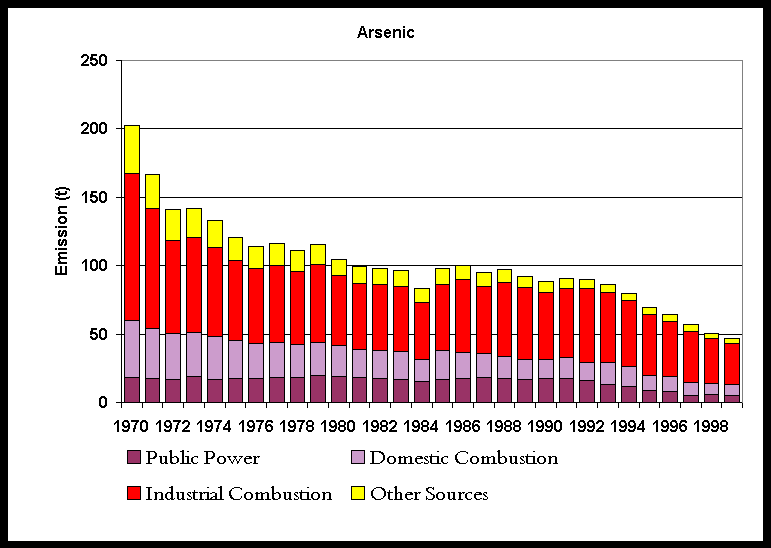
Emissions of Cadmium
Table 6.12 and Figure 6.11 summarise the UK emissions
of cadmium. Emissions have declined by 76% since 1970. The main sources are
non-ferrous metal production and iron and steel manufacture. The former
includes a lead-zinc smelting plant and a number of lead battery recycling
plants. The estimate for energy production includes a significant proportion
from waste combustion and fuel oil combustion for electricity generation. The
decline in emissions is a result of the general fall in coal combustion and the
decline in fuel oil combustion in power generation. The large reduction in
waste emissions is due to improved controls on MSW incinerators from 1997
onwards and their conversion to power generating plant.
Table 6.12 UK Emissions of Cadmium by UN/ECE Category (tonnes)
|
|
1970 |
1980 |
1990 |
1991 |
1992 |
1993 |
1994 |
1995 |
1996 |
1997 |
1998 |
1999 |
1999% |
|
BY UN/ECE
CATEGORY1 |
|
|
|
|
|
|
|
|
|
|
|
|
|
|
Comb. in Energy
Prod. |
|
|
|
|
|
|
|
|
|
|
|
|
|
|
Public Power |
4.0 |
3.1 |
2.9 |
2.8 |
2.4 |
2.0 |
1.6 |
1.2 |
1.2 |
0.6 |
0.6 |
0.4 |
7% |
|
Public Power (waste) |
|
|
1.2 |
1.2 |
1.5 |
2.1 |
3.3 |
0.5 |
0.2 |
0.2 |
0.1 |
0.1 |
1% |
|
Petroleum Refining
Plants |
0.2 |
0.2 |
0.2 |
0.2 |
0.2 |
0.2 |
0.2 |
0.2 |
0.2 |
0.2 |
0.2 |
0.2 |
3% |
|
Other Comb. &
Trans. |
0.2 |
0.1 |
0.0 |
0.0 |
0.0 |
0.0 |
0.0 |
0.0 |
0.0 |
0.0 |
0.0 |
0.0 |
0% |
|
Comb. in
Comm/Inst/Res |
|
|
|
|
|
|
|
|
|
|
|
|
|
|
Residential Plant |
1.4 |
0.8 |
0.5 |
0.5 |
0.4 |
0.5 |
0.5 |
0.4 |
0.4 |
0.3 |
0.3 |
0.3 |
5% |
|
Comm/Pub/Agri Comb. |
0.6 |
0.2 |
0.1 |
0.1 |
0.1 |
0.1 |
0.1 |
0.1 |
0.1 |
0.1 |
0.0 |
0.0 |
0% |
|
Combustion in
Industry |
|
|
|
|
|
|
|
|
|
|
|
|
|
|
Iron & Steel
Comb. |
1.8 |
0.8 |
0.8 |
0.7 |
0.8 |
0.8 |
0.7 |
0.6 |
0.5 |
0.4 |
0.4 |
0.3 |
5% |
|
Non-Ferrous Metals |
2.7 |
2.0 |
2.2 |
2.2 |
2.2 |
2.3 |
2.2 |
2.3 |
2.2 |
2.7 |
1.4 |
1.6 |
25% |
|
Glass Production |
1.5 |
1.7 |
1.8 |
1.8 |
1.7 |
1.5 |
1.3 |
1.2 |
1.1 |
0.9 |
0.7 |
0.5 |
8% |
|
Other Ind. Comb. |
2.5 |
1.1 |
1.0 |
1.0 |
1.1 |
1.1 |
1.0 |
1.0 |
0.9 |
0.8 |
0.7 |
0.6 |
9% |
|
Production
Processes |
|
|
|
|
|
|
|
|
|
|
|
|
|
|
Iron & Steel |
1.3 |
0.9 |
1.2 |
1.1 |
1.1 |
1.1 |
1.1 |
1.2 |
1.1 |
1.2 |
1.1 |
0.8 |
12% |
|
Non-Ferrous Metals |
0.1 |
0.1 |
0.1 |
0.1 |
0.1 |
0.1 |
0.1 |
0.1 |
0.1 |
0.1 |
0.1 |
0.1 |
2% |
|
Processes in Industry |
0.7 |
0.6 |
0.5 |
0.5 |
0.5 |
0.4 |
0.4 |
0.4 |
0.4 |
0.4 |
0.4 |
0.4 |
7% |
|
Road Transport |
|
|
|
|
|
|
|
|
|
|
|
|
|
|
Combustion |
0.2 |
0.2 |
0.3 |
0.3 |
0.3 |
0.4 |
0.4 |
0.4 |
0.4 |
0.4 |
0.4 |
0.4 |
6% |
|
Brake & Tyre Wear |
0.0 |
0.0 |
0.0 |
0.0 |
0.0 |
0.0 |
0.0 |
0.0 |
0.0 |
0.0 |
0.0 |
0.0 |
0% |
|
Other Trans/Mach |
0.1 |
0.0 |
0.0 |
0.0 |
0.0 |
0.0 |
0.0 |
0.0 |
0.0 |
0.0 |
0.0 |
0.0 |
1% |
|
Waste |
9.4 |
9.4 |
8.3 |
8.3 |
8.0 |
7.4 |
6.2 |
2.9 |
1.6 |
0.5 |
0.6 |
0.6 |
10% |
|
By FUEL TYPE |
|
|
|
|
|
|
|
|
|
|
|
|
|
|
Solid |
5.7 |
3.5 |
2.9 |
3.0 |
2.9 |
2.7 |
2.4 |
2.0 |
1.8 |
1.5 |
1.4 |
1.2 |
18% |
|
Petroleum |
3.1 |
2.0 |
1.9 |
1.8 |
1.5 |
1.3 |
1.1 |
1.0 |
1.1 |
0.7 |
0.7 |
0.7 |
11% |
|
Gas |
0.0 |
0.0 |
0.0 |
0.0 |
0.0 |
0.0 |
0.0 |
0.0 |
0.0 |
0.0 |
0.0 |
0.0 |
0% |
|
Non-Fuel |
17.7 |
15.8 |
16.4 |
16.0 |
16.0 |
15.9 |
15.6 |
9.4 |
7.5 |
6.6 |
5.0 |
4.6 |
71% |
|
TOTAL |
26.5 |
21.3 |
21.2 |
20.8 |
20.4 |
19.9 |
19.1 |
12.3 |
10.4 |
8.7 |
7.1 |
6.5 |
100% |
1 See Appendix 4 for definition of UN/ECE
Categories
Figure 6.11 UK Emissions of Cadmium
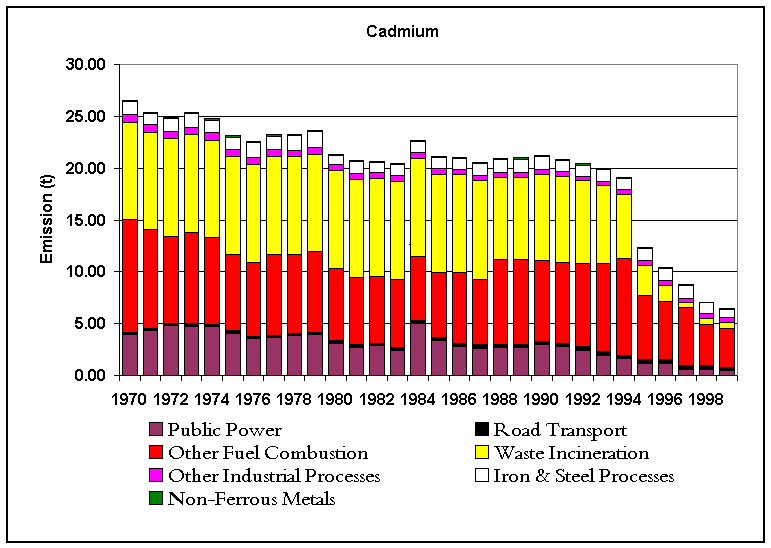
Emissions of Chromium
Table 6.13 and Figure 6.12 summarise the UK emissions
of chromium. Emissions have fallen by 68% since 1970. The largest sources are
various forms of coal combustion, iron and steel production processes, and
other industrial processes. There have been significant revisions based on data
from the Pollution Inventory. In particular, emission estimates have been added
for a specialist chemical company manufacturing chromium-based products under a
new category ‘chromium chemicals’, which is included under
‘Processes in Industry’. This has led to a substantial improvement in
the estimate of emissions of chromium compared with last year.
Table 6.13 UK Emissions of Chromium by UN/ECE Category (tonnes)
|
|
1970 |
1980 |
1990 |
1991 |
1992 |
1993 |
1994 |
1995 |
1996 |
1997 |
1998 |
1999 |
1999% |
|
BY UN/ECE
CATEGORY1 |
|
|
|
|
|
|
|
|
|
|
|
|
|
|
Comb. in Energy
Prod. |
|
|
|
|
|
|
|
|
|
|
|
|
|
|
Public Power |
50.6 |
57.5 |
53.0 |
52.6 |
49.4 |
41.1 |
36.5 |
27.7 |
25.6 |
17.1 |
16.8 |
17.2 |
26% |
|
Public Power (waste) |
|
|
2.2 |
2.2 |
2.7 |
3.7 |
6.0 |
4.2 |
2.3 |
0.2 |
0.3 |
0.1 |
0% |
|
Petroleum Refining
Plants |
0.5 |
0.5 |
0.3 |
0.4 |
0.4 |
0.4 |
0.4 |
0.4 |
0.4 |
0.4 |
0.4 |
0.4 |
1% |
|
Other Comb. &
Trans. |
3.1 |
1.1 |
0.2 |
0.2 |
0.1 |
0.1 |
0.0 |
0.0 |
0.0 |
0.0 |
0.0 |
0.0 |
0% |
|
Comb. in
Comm/Inst/Res |
|
|
|
|
|
|
|
|
|
|
|
|
|
|
Residential Plant |
28.3 |
13.4 |
7.0 |
7.7 |
6.6 |
7.5 |
6.5 |
4.7 |
4.8 |
4.2 |
3.9 |
4.1 |
6% |
|
Comm/Pub/Agri Comb. |
8.3 |
2.5 |
1.4 |
1.3 |
1.1 |
1.1 |
0.9 |
0.7 |
0.7 |
0.7 |
0.4 |
0.3 |
0% |
|
Combustion in
Industry |
|
|
|
|
|
|
|
|
|
|
|
|
|
|
Iron & Steel
Comb. |
4.6 |
1.6 |
1.7 |
1.6 |
1.6 |
1.6 |
1.6 |
1.5 |
1.4 |
1.3 |
1.3 |
1.2 |
2% |
|
Non-Ferrous Metals |
0.1 |
0.1 |
0.1 |
0.1 |
0.1 |
0.1 |
0.1 |
0.1 |
0.1 |
0.1 |
0.1 |
0.0 |
0% |
|
Glass Production |
5.8 |
6.7 |
6.9 |
6.8 |
6.7 |
6.0 |
5.4 |
4.9 |
4.6 |
4.0 |
3.3 |
3.1 |
5% |
|
Other Ind. Comb. |
35.9 |
14.2 |
10.3 |
11.0 |
12.4 |
10.9 |
10.4 |
8.6 |
7.0 |
6.3 |
5.0 |
4.6 |
7% |
|
Production
Processes |
|
|
|
|
|
|
|
|
|
|
|
|
|
|
Iron & Steel |
30.9 |
24.9 |
26.6 |
22.6 |
23.6 |
24.6 |
25.0 |
25.8 |
24.4 |
25.9 |
22.5 |
14.9 |
22% |
|
Non-Ferrous Metals |
0.0 |
0.0 |
0.0 |
0.0 |
0.0 |
0.0 |
0.0 |
0.0 |
0.0 |
0.0 |
0.0 |
0.0 |
0% |
|
Processes in Industry |
28.4 |
24.6 |
24.1 |
23.9 |
23.6 |
23.5 |
23.5 |
23.5 |
23.0 |
25.9 |
27.6 |
20.2 |
30% |
|
Road Transport |
0.2 |
0.2 |
0.3 |
0.3 |
0.3 |
0.4 |
0.4 |
0.4 |
0.4 |
0.4 |
0.4 |
0.4 |
1% |
|
Other Trans/Mach |
0.2 |
0.1 |
0.1 |
0.1 |
0.1 |
0.1 |
0.1 |
0.1 |
0.1 |
0.1 |
0.1 |
0.1 |
0% |
|
Waste |
13.1 |
13.1 |
10.9 |
10.9 |
10.4 |
9.4 |
7.1 |
4.7 |
2.4 |
0.0 |
0.0 |
0.0 |
0% |
|
By FUEL TYPE |
|
|
|
|
|
|
|
|
|
|
|
|
|
|
Solid |
116.7 |
82.6 |
68.3 |
69.3 |
66.3 |
57.4 |
51.0 |
39.1 |
35.7 |
26.3 |
24.3 |
25.1 |
38% |
|
Petroleum |
10.9 |
6.1 |
3.4 |
3.6 |
3.5 |
3.5 |
3.2 |
2.7 |
2.5 |
1.9 |
1.7 |
1.3 |
2% |
|
Gas |
0.0 |
0.0 |
0.0 |
0.0 |
0.0 |
0.0 |
0.0 |
0.0 |
0.0 |
0.0 |
0.0 |
0.0 |
0% |
|
Non-Fuel |
82.5 |
71.6 |
73.4 |
68.9 |
69.5 |
69.5 |
69.7 |
65.6 |
59.1 |
58.4 |
56.0 |
40.3 |
60% |
|
TOTAL |
210.0 |
160.4 |
145.1 |
141.8 |
139.3 |
130.4 |
123.9 |
107.3 |
97.2 |
86.6 |
82.0 |
66.7 |
100% |
1 See Appendix 4 for definition of UN/ECE
Categories
Figure 6.12 UK Emissions of Chromium
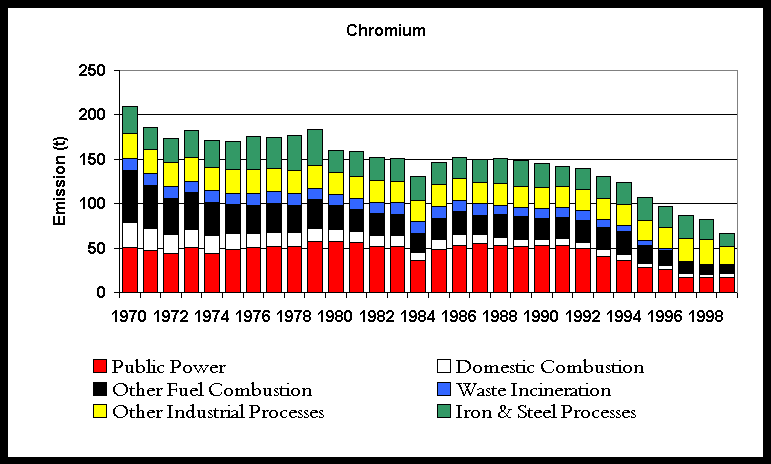
Emissions of Copper
Table 6.14 and Figure 6.13 summarise the UK emissions
of copper. Emissions have declined by 72% since 1970. The main sources are coal
combustion, iron and steel manufacture and non-ferrous metals production.
Emissions have declined over the period due to the decline in coal combustion
and to a lesser extent the combustion of heavy fuel oil. The large reduction in
waste emissions is due to improved controls on MSW waste incinerators from 1997
and their conversion to power generating plant. However new emission data
reported in the Pollution Inventory has led to emissions being revised
downwards for recent years. The main changes in the inventory are a small
reduction in coke oven emissions in ‘processes in industry’ and a new
large source in ‘other industrial combustion’ – copper refining.
In addition, emissions from cement kilns have been estimated for the first
time.
Table 6.14 UK Emissions of Copper by UN/ECE Category (tonnes)
|
|
1970 |
1980 |
1990 |
1991 |
1992 |
1993 |
1994 |
1995 |
1996 |
1997 |
1998 |
1999 |
1999% |
|
BY UN/ECE
CATEGORY1 |
|
|
|
|
|
|
|
|
|
|
|
|
|
|
Comb. in Energy
Prod. |
|
|
|
|
|
|
|
|
|
|
|
|
|
|
Public Power |
39.5 |
44.5 |
41.1 |
40.7 |
38.1 |
31.7 |
28.1 |
21.3 |
19.7 |
13.1 |
15.7 |
12.5 |
21% |
|
Public Power (waste) |
|
|
3.0 |
3.0 |
3.7 |
5.1 |
8.4 |
6.0 |
3.4 |
0.7 |
0.8 |
0.5 |
1% |
|
Petroleum Refining
Plants |
1.0 |
1.0 |
0.7 |
0.8 |
0.8 |
0.8 |
0.8 |
0.8 |
0.8 |
0.8 |
0.8 |
0.7 |
1% |
|
Other Comb. &
Trans. |
4.0 |
1.4 |
0.2 |
0.2 |
0.2 |
0.1 |
0.0 |
0.0 |
0.0 |
0.0 |
0.0 |
0.0 |
0% |
|
Comb. in
Comm/Inst/Res |
|
|
|
|
|
|
|
|
|
|
|
|
|
|
Residential Plant |
18.9 |
10.3 |
6.1 |
6.9 |
5.9 |
7.2 |
6.6 |
5.0 |
5.1 |
4.3 |
3.8 |
3.8 |
6% |
|
Comm/Pub/Agri Comb. |
26.9 |
11.1 |
6.5 |
6.2 |
5.4 |
4.7 |
3.9 |
2.9 |
3.1 |
3.3 |
2.2 |
1.9 |
3% |
|
Combustion in
Industry |
|
|
|
|
|
|
|
|
|
|
|
|
|
|
Iron & Steel
Comb. |
10.5 |
3.7 |
5.3 |
5.1 |
5.0 |
5.0 |
5.1 |
5.2 |
5.4 |
5.5 |
5.3 |
5.1 |
9% |
|
Non-Ferrous Metals |
25.4 |
19.8 |
15.2 |
9.1 |
5.8 |
6.4 |
6.4 |
7.0 |
7.6 |
8.3 |
7.5 |
6.6 |
11% |
|
Glass Production |
1.5 |
1.7 |
1.8 |
1.8 |
1.7 |
1.5 |
1.4 |
1.3 |
1.2 |
1.0 |
0.9 |
0.7 |
1% |
|
Other Ind. Comb. |
46.8 |
18.3 |
14.8 |
16.0 |
17.8 |
16.6 |
15.4 |
13.5 |
11.3 |
10.2 |
8.4 |
8.7 |
15% |
|
Production
Processes |
|
|
|
|
|
|
|
|
|
|
|
|
|
|
Iron & Steel |
12.3 |
6.7 |
9.9 |
9.1 |
9.1 |
9.2 |
9.5 |
9.7 |
9.8 |
10.1 |
9.5 |
8.5 |
14% |
|
Non-Ferrous Metals |
3.3 |
2.3 |
2.7 |
2.4 |
2.3 |
2.3 |
2.3 |
2.4 |
2.4 |
1.6 |
2.0 |
4.1 |
7% |
|
Processes in Industry |
3.6 |
3.5 |
4.4 |
4.5 |
4.6 |
4.6 |
4.9 |
5.1 |
5.1 |
5.2 |
5.2 |
4.7 |
8% |
|
Road Transport |
0.3 |
0.4 |
0.6 |
0.6 |
0.6 |
0.6 |
0.6 |
0.6 |
0.6 |
0.6 |
0.6 |
0.6 |
1% |
|
Other Trans/Mach |
0.3 |
0.1 |
0.1 |
0.1 |
0.1 |
0.2 |
0.2 |
0.2 |
0.2 |
0.1 |
0.1 |
0.1 |
0% |
|
Waste |
19.7 |
19.7 |
16.8 |
16.7 |
16.1 |
14.6 |
11.5 |
8.2 |
4.5 |
0.4 |
0.4 |
0.4 |
1% |
|
By FUEL TYPE |
|
|
|
|
|
|
|
|
|
|
|
|
|
|
Solid |
122.8 |
77.9 |
64.6 |
65.8 |
63.3 |
56.4 |
50.4 |
39.9 |
36.5 |
29.0 |
28.4 |
24.8 |
42% |
|
Petroleum |
16.5 |
9.3 |
5.2 |
5.5 |
5.4 |
5.3 |
4.9 |
4.1 |
3.9 |
3.1 |
2.8 |
2.2 |
4% |
|
Gas |
0.0 |
0.0 |
0.0 |
0.0 |
0.0 |
0.0 |
0.0 |
0.0 |
0.0 |
0.0 |
0.0 |
0.0 |
0% |
|
Non-Fuel |
74.6 |
57.4 |
59.4 |
52.0 |
48.5 |
49.0 |
49.7 |
45.1 |
39.6 |
33.1 |
32.0 |
32.0 |
54% |
|
TOTAL |
213.9 |
144.5 |
129.2 |
123.3 |
117.2 |
110.7 |
105.1 |
89.1 |
80.0 |
65.2 |
63.1 |
59.1 |
100% |
1 See Appendix 4 for definition of UN/ECE
Categories
Figure 6.13 UK
Emissions of Copper
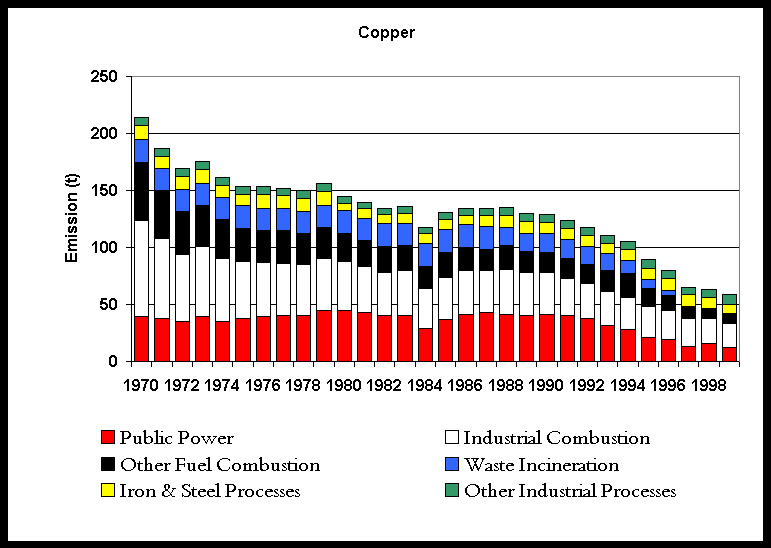
Emissions of Lead
Table 6.15 and Figure 6.14 summarise the UK emissions
of lead. Emissions have declined by 92% since 1970. The largest source is still
from anti-knock lead additives in petrol and it is here where the most
significant reductions have been made. The lead content of leaded petrol was
reduced from around 0.34 g/l to 0.143 g/l in 1986 and since 1987 sales of
unleaded petrol have increased particularly as a result of the increased use of
cars fitted with catalytic converters. Leaded petrol was phased out from
general sale at the end of 1999, and consequently a dramatic reduction in
emissions from the road transport sector is expected for 2000.
Other major sources are non-ferrous metal production and industrial
processes. There has been some reduction in emissions from iron and steel
production processes due to improved abatement measures. Emissions have also
declined as a result of the decreasing use of coal. The large reduction in
waste emissions is due to improved controls on MSW incinerators from 1997
onwards and their conversion to power generating plant. There are only
relatively minor changes since the last inventory. These are an increase in
coke oven emissions in ‘processes in industry’ and a new source in
‘other industrial combustion’ – copper refining. In addition,
emissions from cement kilns have been revised downwards
Table 6.15 UK Emissions of Lead by UN/ECE Category (tonnes)
|
|
1970 |
1980 |
1990 |
1991 |
1992 |
1993 |
1994 |
1995 |
1996 |
1997 |
1998 |
1999 |
1999% |
|
BY UN/ECE
CATEGORY1 |
|
|
|
|
|
|
|
|
|
|
|
|
|
|
Comb. in Energy
Prod. |
|
|
|
|
|
|
|
|
|
|
|
|
|
|
Public Power |
81 |
88 |
82 |
77 |
69 |
48 |
43 |
39 |
38 |
25 |
26 |
16 |
3% |
|
Public Power (waste) |
|
|
22 |
22 |
27 |
37 |
61 |
42 |
22 |
0 |
0 |
1 |
0% |
|
Petroleum Refining
Plants |
1 |
1 |
1 |
1 |
1 |
1 |
1 |
1 |
1 |
1 |
1 |
1 |
0% |
|
Other Comb. &
Trans. |
13 |
4 |
1 |
1 |
1 |
0 |
0 |
0 |
0 |
0 |
0 |
0 |
0% |
|
Comb. in
Comm/Inst/Res |
|
|
|
|
|
|
|
|
|
|
|
|
|
|
Residential Plant |
101 |
49 |
27 |
30 |
26 |
29 |
26 |
19 |
20 |
17 |
16 |
16 |
3% |
|
Comm/Pub/Agri Comb. |
49 |
18 |
9 |
8 |
7 |
6 |
5 |
4 |
4 |
4 |
3 |
2 |
0% |
|
Combustion in
Industry |
|
|
|
|
|
|
|
|
|
|
|
|
|
|
Iron & Steel
Comb. |
30 |
11 |
14 |
13 |
13 |
13 |
13 |
12 |
12 |
11 |
10 |
10 |
2% |
|
Non-Ferrous Metals |
47 |
36 |
36 |
32 |
30 |
32 |
31 |
32 |
32 |
32 |
23 |
21 |
4% |
|
Glass Production |
107 |
123 |
127 |
125 |
122 |
110 |
101 |
91 |
86 |
75 |
65 |
52 |
9% |
|
Other Ind. Comb. |
140 |
55 |
49 |
52 |
57 |
53 |
51 |
46 |
38 |
34 |
27 |
27 |
5% |
|
Production
Processes |
|
|
|
|
|
|
|
|
|
|
|
|
|
|
Iron & Steel |
46 |
36 |
44 |
38 |
39 |
40 |
42 |
43 |
41 |
43 |
38 |
34 |
6% |
|
Non-Ferrous Metals |
6 |
5 |
3 |
2 |
2 |
2 |
3 |
3 |
4 |
3 |
6 |
4 |
1% |
|
Processes in Industry |
105 |
99 |
99 |
98 |
98 |
98 |
98 |
85 |
73 |
113 |
91 |
32 |
6% |
|
Road Transport |
6363 |
7445 |
2173 |
1937 |
1726 |
1525 |
1295 |
1066 |
909 |
799 |
591 |
327 |
59% |
|
Other Trans/Mach |
119 |
92 |
19 |
18 |
16 |
14 |
12 |
10 |
9 |
8 |
6 |
6 |
1% |
|
Waste |
149 |
149 |
127 |
127 |
122 |
112 |
89 |
64 |
33 |
3 |
4 |
4 |
1% |
|
By FUEL TYPE |
|
|
|
|
|
|
|
|
|
|
|
|
|
|
Solid |
352 |
193 |
151 |
153 |
146 |
125 |
112 |
96 |
90 |
73 |
66 |
56 |
10% |
|
Petroleum |
6512 |
7553 |
2201 |
1964 |
1751 |
1546 |
1314 |
1081 |
923 |
810 |
600 |
336 |
61% |
|
Gas |
0 |
0 |
0 |
0 |
0 |
0 |
0 |
0 |
0 |
0 |
0 |
0 |
0% |
|
Non-Fuel |
493 |
466 |
479 |
464 |
459 |
450 |
442 |
378 |
308 |
286 |
240 |
161 |
29% |
|
TOTAL |
7357 |
8212 |
2831 |
2581 |
2356 |
2121 |
1869 |
1555 |
1321 |
1170 |
906 |
553 |
100% |
1 See Appendix 4 for definition of UN/ECE
Categories
Figure
6.14 UK Emissions of Lead
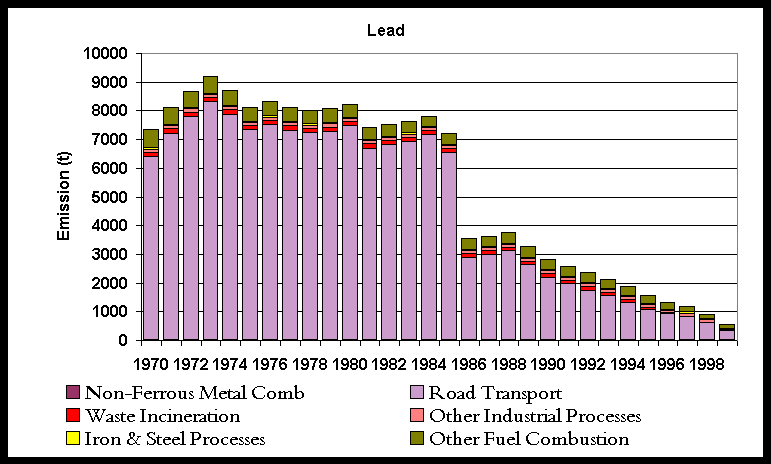
Emissions of Mercury
Table 6.16a and Figure 6.15 summarise the UK
emissions of mercury. Emissions have declined by 81% since 1970. The main
sources are waste incineration, the manufacture of chlorine in mercury cells,
non-ferrous metal production and coal combustion. Emissions have declined as a
result of improved controls on mercury cells and their replacement by diaphragm
or membrane cells and the decline of coal use. The large reduction in waste
emissions is due to improved controls on MSW incinerators from 1997 onwards and
their conversion to power generating plant. There are only relatively minor
changes since the last inventory. These are an increase in cement kiln
emissions in ‘industrial combustion’ and a small revision upwards in
MSW incineration emissions.
Table 6.16a UK Emissions of Mercury by UN/ECE Category (tonnes)
|
|
1970 |
1980 |
1990 |
1991 |
1992 |
1993 |
1994 |
1995 |
1996 |
1997 |
1998 |
1999 |
1999% |
|
BY UN/ECE
CATEGORY1 |
|
|
|
|
|
|
|
|
|
|
|
|
|
|
Comb. in Energy
Prod. |
|
|
|
|
|
|
|
|
|
|
|
|
|
|
Public Power |
7.5 |
8.1 |
7.5 |
7.4 |
6.9 |
4.7 |
4.4 |
4.1 |
2.6 |
1.6 |
2.3 |
1.6 |
18% |
|
Public Power (waste) |
|
|
0.9 |
0.9 |
1.1 |
1.5 |
2.4 |
0.3 |
0.3 |
1.4 |
0.4 |
0.1 |
1% |
|
Petroleum Refining
Plants |
0.1 |
0.1 |
0.1 |
0.1 |
0.1 |
0.1 |
0.1 |
0.1 |
0.1 |
0.1 |
0.1 |
0.1 |
1% |
|
Other Comb. &
Trans. |
0.5 |
0.2 |
0.0 |
0.0 |
0.0 |
0.0 |
0.0 |
0.0 |
0.0 |
0.0 |
0.0 |
0.0 |
0% |
|
Comb. in
Comm/Inst/Res |
|
|
|
|
|
|
|
|
|
|
|
|
|
|
Residential Plant |
3.9 |
1.9 |
1.0 |
1.2 |
1.0 |
1.2 |
1.0 |
0.8 |
0.8 |
0.7 |
0.6 |
0.6 |
7% |
|
Comm/Pub/Agri Comb. |
2.3 |
0.9 |
0.5 |
0.5 |
0.4 |
0.4 |
0.3 |
0.2 |
0.2 |
0.3 |
0.2 |
0.1 |
2% |
|
Combustion in
Industry |
|
|
|
|
|
|
|
|
|
|
|
|
|
|
Iron & Steel
Comb. |
0.9 |
0.4 |
0.3 |
0.3 |
0.3 |
0.3 |
0.3 |
0.3 |
0.3 |
0.3 |
0.3 |
0.3 |
4% |
|
Non-Ferrous Metals |
1.6 |
1.2 |
1.3 |
1.4 |
1.4 |
1.5 |
1.4 |
1.5 |
1.4 |
1.5 |
1.4 |
0.3 |
4% |
|
Glass Production |
0.1 |
0.1 |
0.2 |
0.1 |
0.1 |
0.1 |
0.1 |
0.1 |
0.1 |
0.1 |
0.1 |
0.1 |
1% |
|
Other Ind. Comb. |
5.4 |
2.2 |
2.2 |
2.2 |
2.4 |
2.3 |
2.2 |
2.1 |
1.8 |
1.7 |
1.5 |
1.3 |
15% |
|
Production
Processes |
|
|
|
|
|
|
|
|
|
|
|
|
|
|
Iron & Steel |
0.4 |
0.3 |
0.4 |
0.3 |
0.3 |
0.3 |
0.3 |
0.3 |
0.3 |
0.4 |
0.3 |
0.3 |
4% |
|
Non-Ferrous Metals |
0.0 |
0.0 |
0.0 |
0.0 |
0.0 |
0.0 |
0.0 |
0.0 |
0.0 |
0.0 |
0.0 |
0.0 |
0% |
|
Processes in Industry |
13.5 |
12.3 |
8.1 |
8.9 |
7.4 |
3.3 |
3.6 |
4.2 |
2.4 |
1.0 |
1.3 |
1.5 |
18% |
|
Road Transport |
0.0 |
0.0 |
0.0 |
0.0 |
0.0 |
0.0 |
0.0 |
0.0 |
0.0 |
0.0 |
0.0 |
0.0 |
0% |
|
Other Trans/Mach |
0.0 |
0.0 |
0.0 |
0.0 |
0.0 |
0.0 |
0.0 |
0.0 |
0.0 |
0.0 |
0.0 |
0.0 |
0% |
|
Waste |
|
|
|
|
|
|
|
|
|
|
|
|
|
|
Landfill |
0.6 |
0.6 |
0.6 |
0.6 |
0.5 |
0.5 |
0.4 |
0.4 |
0.4 |
0.4 |
0.4 |
0.4 |
5% |
|
Waste Incineration |
7.3 |
7.6 |
6.8 |
6.8 |
6.6 |
6.2 |
5.3 |
2.9 |
2.5 |
1.8 |
1.8 |
1.8 |
21% |
|
By FUEL TYPE |
|
|
|
|
|
|
|
|
|
|
|
|
|
|
Solid |
18.1 |
12.3 |
10.3 |
10.5 |
10.0 |
7.9 |
7.3 |
6.5 |
4.8 |
3.8 |
4.2 |
3.4 |
39% |
|
Petroleum |
1.2 |
0.7 |
0.6 |
0.5 |
0.4 |
0.4 |
0.3 |
0.3 |
0.3 |
0.1 |
0.1 |
0.1 |
1% |
|
Gas |
0.0 |
0.0 |
0.0 |
0.0 |
0.0 |
0.0 |
0.0 |
0.0 |
0.0 |
0.0 |
0.0 |
0.0 |
0% |
|
Non-Fuel |
24.9 |
22.8 |
18.9 |
19.6 |
18.1 |
14.0 |
14.2 |
10.5 |
8.1 |
7.2 |
6.4 |
5.1 |
59% |
|
TOTAL |
44.3 |
35.8 |
29.8 |
30.6 |
28.5 |
22.3 |
21.8 |
17.3 |
13.2 |
11.2 |
10.7 |
8.5 |
100% |
1 See Appendix 4 for definition of UN/ECE
Categories
Figure 6.15 UK Emissions of Mercury
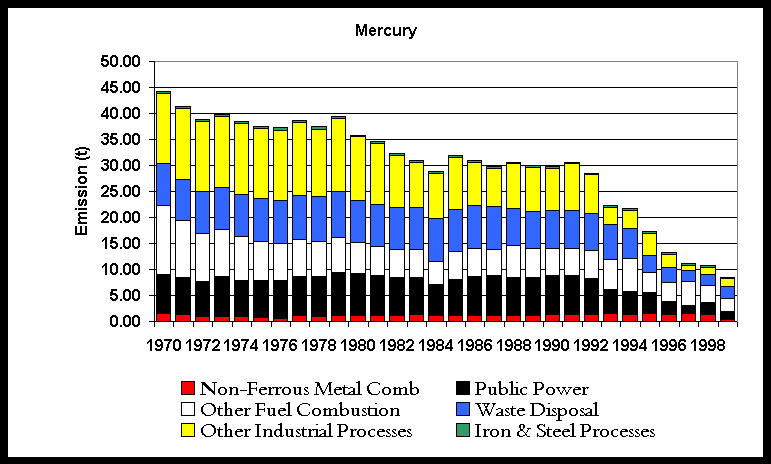
Speciation of Mercury Emissions
When mercury is emitted to air it occurs in one of several different
forms, and the emissions of each of these forms has been estimated
individually- the emissions have been "speciated".
Three species of mercury have been considered
- Hg0 unreactive gaseous elemental Hg
- Hg-p attached to particulate material
- RGM reactive gaseous mercury (includes both inorganic and
organic forms normally
in the Hg2+ oxidised form)
The methodology for estimating the emissions of each of these three
species is similar to that used for speciating the VOC emissions. Each source
of mercury emission is considered individually. A speciation profile
identifying the fractional contribution from each species to the mercury
emission from that source is then applied. Summing across the individual
sources then allows a total for each of the three species to be evaluated.
Table 6.16b Speciated Emissions of Mercury (tonnes)
|
|
Hg(0) |
Hg-p |
RGM |
Total
(1999) |
|
BY UN/ECE
CATEGORY1 |
|
|
|
|
|
Comb. in Energy
Prod. |
0.46 |
0.06 |
1.23 |
1.75 |
|
Comb. in
Comm/Inst/Res |
0.30 |
0.13 |
0.29 |
0.72 |
|
Combustion in
Industry |
0.96 |
0.11 |
0.88 |
1.95 |
|
Production
Processes |
1.31 |
0.02 |
0.49 |
1.83 |
|
Road Transport |
0.00 |
0.00 |
0.00 |
0.00 |
|
Other Trans/Mach |
0.01 |
0.00 |
0.01 |
0.02 |
|
Waste |
0.18 |
0.14 |
1.90 |
2.22 |
|
TOTAL |
3.23 |
0.48 |
4.79 |
8.50 |
The data which have been used to generate the
speciation profiles for each of the source emissions have come from a number of
different reports (Lee et al 2001, Pacyna 1999, Clarke and Sloss
1992, Davidson and Clarke 1996,) and personal communications (Pacyna 2001,
Scott and Jones 2001, Fynes and Crowther 2001, Patrick and Snape
2001).
There are a number of areas where the emission inventory may be
improved.
- There appear to be differences in the species according to abatement
used in power stations burning coal (e.g. Flue Gas Desulphurisation and
Electrostatic Precipitation). At present the specific form of abatement which
is used has not been included, and therefore these differences have not been
accounted for in the emission estimates presented here.
- To date, only a small amount of data on Hg species emitted from
domestic coal combustion has been obtained. Additional data are required to
give the speciation increased certainty.
- Similarly, there is little information on Hg species emitted from
crematoria, and more data are required.
These areas will be investigated for future reports.
Emissions of Nickel
Table 6.17 and Figure 6.16 summarise the UK emissions
of nickel. Emissions have declined by 89% since 1970. The main sources of
nickel emissions are the combustion of coal and heavy fuel oil. These have
declined in use since 1970 in favour of natural gas and are largely responsible
for the reduction in total emissions. Since 1989 heavy fuel oil has been
replaced by Orimulsion (an emulsion of bitumen in water) in some power stations
though this has now been discontinued. The nickel content of Orimulsion was
higher than that of heavy fuel oil and resulted in higher emissions in spite of
the flue gas cleaning equipment required on these power stations. Emissions
from refineries are important because of the large amount of refinery fuel oil
and residues burnt. There have been significant revisions based on data from
the Pollution Inventory. In particular, a large source pertaining to nickel
chromium use has been added under ‘iron & steel processes’ as
well as a significant increase in coke oven emissions under ‘processes in
industry’. Industrial combustion has been revised upwards due to new
cement kiln data. Glass production now includes flat glass as well as container
glass.
Table 6.17 UK Emissions of Nickel by UN/ECE Category (tonnes)
|
|
1970 |
1980 |
1990 |
1991 |
1992 |
1993 |
1994 |
1995 |
1996 |
1997 |
1998 |
1999 |
1999% |
|
BY UN/ECE
CATEGORY1 |
|
|
|
|
|
|
|
|
|
|
|
|
|
|
Comb. in Energy
Prod. |
|
|
|
|
|
|
|
|
|
|
|
|
|
|
Public Power |
143.5 |
95.5 |
95.7 |
92.4 |
92.6 |
81.4 |
68.3 |
57.9 |
52.5 |
16.9 |
15.4 |
10.8 |
7% |
|
Public Power (waste) |
|
|
1.3 |
1.3 |
1.6 |
2.2 |
3.6 |
2.6 |
1.4 |
0.3 |
0.4 |
0.5 |
0% |
|
Petroleum Refining
Plants |
47.5 |
45.8 |
33.4 |
37.0 |
37.8 |
39.3 |
38.9 |
38.5 |
38.6 |
39.4 |
38.5 |
34.8 |
24% |
|
Other Comb. &
Trans. |
12.1 |
4.2 |
0.7 |
0.7 |
0.5 |
0.3 |
0.1 |
0.1 |
0.1 |
0.1 |
0.1 |
0.1 |
0% |
|
Comb in
Comm/Inst/Res |
|
|
|
|
|
|
|
|
|
|
|
|
|
|
Residential Plant |
159.0 |
71.4 |
34.9 |
37.8 |
33.1 |
36.0 |
30.2 |
21.9 |
22.2 |
19.5 |
18.4 |
20.2 |
14% |
|
Comm/Pub/Agri Comb. |
190.0 |
78.9 |
38.8 |
38.7 |
40.6 |
42.5 |
42.3 |
35.6 |
33.0 |
24.2 |
18.8 |
14.8 |
10% |
|
Combustion in
Industry |
|
|
|
|
|
|
|
|
|
|
|
|
|
|
Iron & Steel
Comb. |
44.5 |
11.3 |
6.3 |
6.4 |
6.2 |
7.4 |
7.2 |
7.1 |
6.1 |
5.9 |
4.4 |
4.5 |
3% |
|
Non-Ferrous Metals |
0.1 |
0.1 |
0.1 |
0.1 |
0.0 |
0.1 |
0.0 |
0.1 |
0.1 |
0.1 |
0.2 |
0.4 |
0% |
|
Glass Production |
4.7 |
5.4 |
5.6 |
5.5 |
5.4 |
4.8 |
4.4 |
3.9 |
3.7 |
3.2 |
2.7 |
2.2 |
1% |
|
Other Ind. Comb. |
663.6 |
354.1 |
167.2 |
185.2 |
189.8 |
180.3 |
163.6 |
122.7 |
102.3 |
77.9 |
65.9 |
38.6 |
26% |
|
|
|
|
|
|
|
|
|
|
|
|
|
|
|
|
Production
Processes |
23.2 |
18.2 |
19.7 |
16.8 |
17.5 |
18.2 |
18.6 |
19.1 |
18.1 |
19.2 |
16.8 |
9.8 |
7% |
|
Iron & Steel
Comb. |
2.3 |
4.9 |
4.3 |
4.4 |
3.9 |
3.8 |
3.8 |
4.1 |
4.2 |
4.2 |
4.4 |
4.5 |
3% |
|
Non-Ferrous Metals |
5.6 |
3.7 |
4.1 |
4.1 |
4.0 |
4.0 |
4.1 |
4.2 |
3.5 |
2.1 |
2.4 |
2.2 |
2% |
|
Processes in Industry |
|
|
|
|
|
|
|
|
|
|
|
|
|
|
Road Transport |
0.7 |
0.9 |
1.2 |
1.2 |
1.2 |
1.3 |
1.3 |
1.3 |
1.3 |
1.3 |
1.3 |
1.3 |
1% |
|
Other Trans/Mach |
13.2 |
2.9 |
2.9 |
4.2 |
4.5 |
5.5 |
6.7 |
7.5 |
6.0 |
4.5 |
3.8 |
2.6 |
2% |
|
Waste |
7.9 |
7.9 |
6.6 |
6.5 |
6.2 |
5.6 |
4.2 |
2.8 |
1.5 |
0.0 |
0.0 |
0.0 |
0% |
|
By FUEL TYPE |
|
|
|
|
|
|
|
|
|
|
|
|
|
|
Solid |
338.4 |
154.4 |
108.6 |
114.1 |
111.9 |
106.0 |
93.1 |
74.8 |
68.4 |
58.4 |
54.6 |
50.2 |
34% |
|
Petroleum |
930.5 |
507.6 |
269.1 |
286.4 |
291.3 |
284.9 |
262.1 |
214.4 |
190.3 |
128.0 |
108.6 |
75.3 |
51% |
|
Gas |
0.0 |
0.0 |
0.0 |
0.0 |
0.0 |
0.0 |
0.0 |
0.0 |
0.0 |
0.0 |
0.0 |
0.0 |
0% |
|
Non-Fuel |
48.8 |
43.0 |
45.2 |
41.9 |
41.7 |
41.7 |
42.0 |
40.1 |
35.9 |
32.6 |
30.2 |
21.8 |
15% |
|
TOTAL |
1317.8 |
705.0 |
422.9 |
442.4 |
444.9 |
432.6 |
397.2 |
329.3 |
294.7 |
219.0 |
193.5 |
147.3 |
100% |
1 See Appendix 4 for definition of UN/ECE
Categories
Figure 6.16 UK Emissions of Nickel
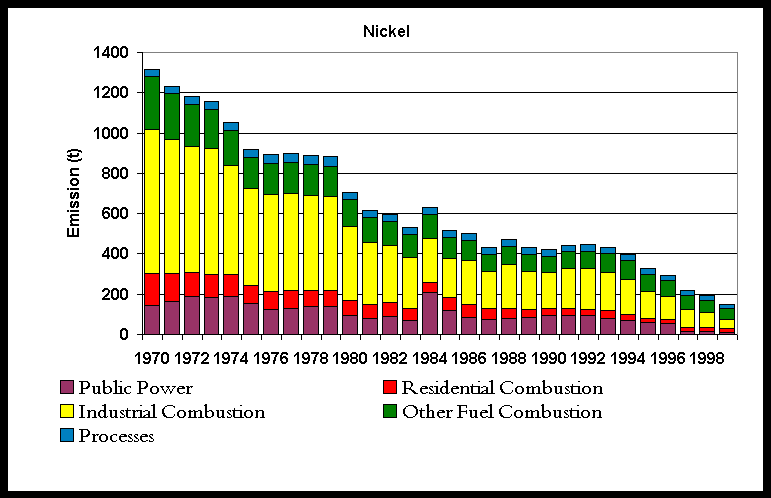
Emissions of Selenium
Table 6.18 and Figure 6.17 summarise the UK emissions
of selenium. Emissions have declined by 75% since 1970. The main source of
selenium emissions is coal combustion in early years. Only trace amounts are
emitted by the combustion of petroleum based fuels. Emissions have reduced over
time because of the decline in coal use in favour of natural gas combustion.
Consequently glass production is now the dominant source. The estimate for
glass manufacture is uncertain because it is based on very limited data.
Emissions from glass production have been revised upwards a little due to the
inclusion of flat glass production as well as container glass.
Table 6.18 UK Emissions of Selenium by UN/ECE Category (tonnes)
|
|
1970 |
1980 |
1990 |
1991 |
1992 |
1993 |
1994 |
1995 |
1996 |
1997 |
1998 |
1999 |
1999% |
|
BY UN/ECE CATEGORY |
|
|
|
|
|
|
|
|
|
|
|
|
|
|
Comb. in Energy
Prod. |
|
|
|
|
|
|
|
|
|
|
|
|
|
|
Public Power |
53.4 |
59.9 |
55.3 |
54.8 |
51.2 |
42.6 |
37.7 |
28.7 |
26.5 |
17.6 |
22.0 |
11.5 |
26% |
|
Public Power (waste) |
|
|
0.0 |
0.0 |
0.0 |
0.0 |
0.1 |
0.1 |
0.0 |
0.0 |
0.0 |
0.0 |
0% |
|
Petroleum Refining
Plants |
2.0 |
1.9 |
1.1 |
1.2 |
1.2 |
1.3 |
1.3 |
1.2 |
1.2 |
1.2 |
1.2 |
1.0 |
2% |
|
Other Comb. &
Trans. |
2.5 |
0.9 |
0.2 |
0.1 |
0.1 |
0.1 |
0.0 |
0.0 |
0.0 |
0.0 |
0.0 |
0.0 |
0% |
|
Comb. in
Comm/Inst/Res |
|
|
|
|
|
|
|
|
|
|
|
|
|
|
Residential Plant |
32.7 |
14.8 |
7.3 |
7.9 |
7.0 |
7.6 |
6.3 |
4.5 |
4.7 |
4.1 |
3.9 |
4.3 |
10% |
|
Comm/Pub/Agri Comb. |
8.7 |
2.9 |
1.6 |
1.5 |
1.3 |
1.3 |
1.1 |
0.9 |
0.9 |
0.8 |
0.5 |
0.4 |
1% |
|
Combustion in
Industry |
|
|
|
|
|
|
|
|
|
|
|
|
|
|
Iron & Steel
Comb. |
2.0 |
0.5 |
0.4 |
0.4 |
0.4 |
0.4 |
0.4 |
0.4 |
0.4 |
0.4 |
0.4 |
0.4 |
1% |
|
Non-Ferrous Metals |
0.9 |
0.8 |
0.8 |
0.8 |
0.9 |
0.9 |
0.9 |
0.8 |
0.9 |
1.0 |
0.9 |
0.7 |
1% |
|
Glass Production |
44.1 |
50.9 |
53.1 |
52.2 |
50.8 |
45.3 |
41.3 |
37.1 |
35.1 |
30.6 |
26.0 |
20.4 |
46% |
|
Other Ind. Comb. |
31.6 |
12.7 |
10.0 |
10.8 |
11.9 |
11.2 |
10.4 |
9.0 |
7.6 |
6.8 |
5.6 |
4.9 |
11% |
|
Production
Processes |
|
|
|
|
|
|
|
|
|
|
|
|
|
|
Iron & Steel
Comb. |
0.3 |
0.1 |
0.2 |
0.2 |
0.2 |
0.2 |
0.2 |
0.2 |
0.2 |
0.3 |
0.2 |
0.2 |
1% |
|
Non-Ferrous Metals |
0.0 |
0.0 |
0.0 |
0.0 |
0.0 |
0.0 |
0.0 |
0.0 |
0.0 |
0.0 |
0.0 |
0.0 |
0% |
|
Processes in Industry |
0.0 |
0.0 |
0.0 |
0.0 |
0.0 |
0.0 |
0.0 |
0.0 |
0.0 |
0.0 |
0.0 |
0.0 |
0% |
|
Road Transport |
0.2 |
0.2 |
0.3 |
0.3 |
0.3 |
0.4 |
0.4 |
0.4 |
0.4 |
0.4 |
0.4 |
0.4 |
1% |
|
Other Trans/Mach |
0.2 |
0.0 |
0.0 |
0.1 |
0.1 |
0.1 |
0.1 |
0.1 |
0.1 |
0.1 |
0.1 |
0.0 |
0% |
|
Waste |
0.2 |
0.2 |
0.1 |
0.1 |
0.1 |
0.1 |
0.1 |
0.1 |
0.0 |
0.0 |
0.0 |
0.0 |
0% |
|
By FUEL TYPE |
|
|
|
|
|
|
|
|
|
|
|
|
|
|
Solid |
116.6 |
84.1 |
70.3 |
71.2 |
67.8 |
59.2 |
52.3 |
40.6 |
37.3 |
27.8 |
30.7 |
20.2 |
46% |
|
Petroleum |
15.7 |
9.2 |
5.2 |
5.4 |
5.1 |
5.0 |
4.6 |
3.8 |
3.6 |
2.8 |
2.6 |
2.2 |
5% |
|
Gas |
0.0 |
0.0 |
0.0 |
0.0 |
0.0 |
0.0 |
0.0 |
0.0 |
0.0 |
0.0 |
0.0 |
0.0 |
0% |
|
Non-Fuel |
46.5 |
52.7 |
55.0 |
54.0 |
52.6 |
47.3 |
43.3 |
39.0 |
37.1 |
32.6 |
27.9 |
21.8 |
49% |
|
TOTAL |
178.8 |
146.0 |
130.5 |
130.5 |
125.6 |
111.5 |
100.3 |
83.5 |
78.0 |
63.2 |
61.2 |
44.2 |
100% |
1 See Appendix 4 for definition of UN/ECE
Categories
Figure 6.17 UK Emissions of Selenium
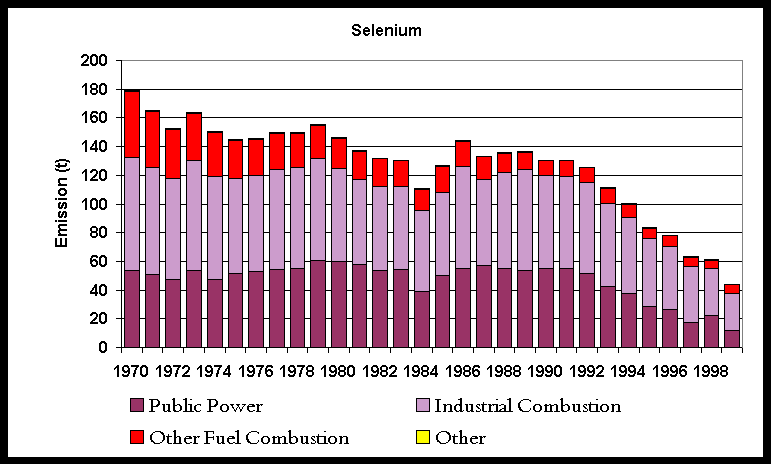
Emissions of Vanadium
Table 6.19 and Figure 6.18 summarise the UK emissions
of vanadium. Emission data are rather scarce so the estimates are very
uncertain. Estimates of emissions have declined by 94% since 1970. The major
source of emissions is the combustion of fuel oils with liquid fuels accounting
for some 73% of the estimated emission in 1999. The reduction in emissions
reflects the decline in the use of fuel oils by the electricity supply
industry, industry in general and the domestic sector. Since 1989, heavy fuel
oil was partly replaced by Orimulsion (an emulsion of bitumen in water) in some
power stations though this has now been discontinued. Emissions from refineries
are very important because of the high consumption of refinery fuel oil and
residues. The vanadium content of Orimulsion was higher than that of heavy fuel
oil and resulted in higher emissions in spite of the flue gas cleaning
equipment required on these power stations. Of the other sources, estimates for
the iron and steel industry are very uncertain since emissions will depend on
the type of steel or alloy produced and its vanadium content. The available
emissions data apply only to a generalised steel production process.
Table 6.19 UK Emissions of Vanadium by UN/ECE Category (tonnes)
|
|
1970 |
1980 |
1990 |
1991 |
1992 |
1993 |
1994 |
1995 |
1996 |
1997 |
1998 |
1999 |
1999% |
|
BY UN/ECE
CATEGORY1 |
|
|
|
|
|
|
|
|
|
|
|
|
|
|
Comb. in Energy
Prod. |
|
|
|
|
|
|
|
|
|
|
|
|
|
|
Public Power |
498 |
285 |
295 |
283 |
292 |
262 |
211 |
185 |
176 |
39 |
19 |
15 |
7% |
|
Public Power (waste) |
|
|
0 |
0 |
1 |
1 |
1 |
1 |
0 |
0 |
0 |
0 |
0% |
|
Petroleum Refining
Plants |
25 |
18 |
16 |
21 |
22 |
25 |
25 |
20 |
24 |
24 |
15 |
13 |
6% |
|
Other Comb. &
Trans. |
12 |
4 |
1 |
1 |
0 |
0 |
0 |
0 |
0 |
0 |
0 |
0 |
0% |
|
Comb. in
Comm/Inst/Res |
|
|
|
|
|
|
|
|
|
|
|
|
|
|
Residential Plant |
68 |
34 |
18 |
20 |
17 |
20 |
20 |
16 |
14 |
12 |
10 |
10 |
4% |
|
Comm/Pub/Agri Comb. |
663 |
287 |
139 |
139 |
150 |
158 |
160 |
135 |
124 |
89 |
71 |
56 |
25% |
|
Combustion in
Industry |
|
|
|
|
|
|
|
|
|
|
|
|
|
|
Iron & Steel
Comb. |
156 |
39 |
23 |
23 |
22 |
27 |
26 |
26 |
22 |
22 |
16 |
16 |
7% |
|
Glass Production |
21 |
24 |
25 |
25 |
24 |
21 |
19 |
17 |
16 |
14 |
12 |
9 |
4% |
|
Other Ind. Comb. |
2264 |
1272 |
543 |
605 |
606 |
579 |
522 |
374 |
312 |
222 |
191 |
89 |
39% |
|
Production
Processes |
|
|
|
|
|
|
|
|
|
|
|
|
|
|
Iron & Steel
Comb. |
12 |
7 |
10 |
9 |
9 |
9 |
9 |
9 |
9 |
10 |
9 |
6 |
3% |
|
Non-Ferrous Metals |
0 |
0 |
0 |
0 |
0 |
0 |
0 |
0 |
0 |
0 |
0 |
0 |
0% |
|
Road Transport |
0 |
0 |
1 |
1 |
1 |
1 |
1 |
1 |
1 |
1 |
1 |
1 |
0% |
|
Other Trans/Mach |
51 |
11 |
11 |
16 |
17 |
21 |
26 |
29 |
23 |
17 |
14 |
10 |
4% |
|
Waste |
3 |
3 |
2 |
2 |
2 |
2 |
1 |
1 |
0 |
0 |
0 |
0 |
0% |
|
By FUEL TYPE |
|
|
|
|
|
|
|
|
|
|
|
|
|
|
Solid |
224 |
110 |
90 |
94 |
94 |
89 |
80 |
66 |
59 |
49 |
44 |
40 |
18% |
|
Petroleum |
3501 |
1834 |
948 |
1007 |
1026 |
997 |
902 |
711 |
628 |
369 |
284 |
164 |
73% |
|
Gas |
0 |
0 |
0 |
0 |
0 |
0 |
0 |
0 |
0 |
0 |
0 |
0 |
0% |
|
Non-Fuel |
47 |
39 |
46 |
44 |
43 |
40 |
39 |
37 |
35 |
33 |
30 |
22 |
10% |
|
TOTAL |
3772 |
1984 |
1083 |
1145 |
1163 |
1126 |
1021 |
814 |
723 |
451 |
357 |
225 |
100% |
1 See Appendix 4 for definition of UN/ECE
Categories
Figure 6.18 UK Emissions of Vanadium
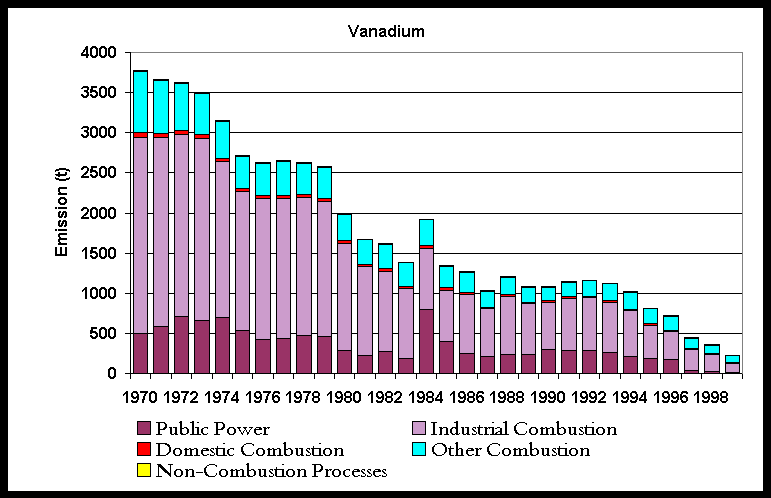
Emissions of Zinc
Table 6.20 and Figure 6.19 summarise the UK emissions
of zinc. Emissions of zinc have declined by 72% since 1970. The main sources
are iron and steel production, non-ferrous metals manufacture, road transport
and to a lesser extent coal combustion. The road transport emission is almost
entirely due to tyre wear. This arises from the zinc content of the tyre rubber
- around 2% ZnO by weight. The reduction in emissions over the period
considered is largely due to the decline in coal combustion and improvements in
abatement measures in the iron and steel industry. The large reduction in waste
emissions is due to improved controls on MSW incinerators from 1997 onwards and
their conversion to power generating plant. However new emission data reported
in the Pollution inventory has led to emissions being revised upwards for
recent years. The main revisions to the inventory are a small increase in coke
oven emissions in ‘processes in industry’ and a new large source in
‘other industrial combustion’ – copper refining. Also there is a
small decrease in cement kiln emissions under ‘industrial
combustion’.
Table 6.20 UK Emissions of Zinc by UN/ECE Category (tonnes)
|
|
1970 |
1980 |
1990 |
1991 |
1992 |
1993 |
1994 |
1995 |
1996 |
1997 |
1998 |
1999 |
1999% |
|
BY UN/ECE
CATEGORY1 |
|
|
|
|
|
|
|
|
|
|
|
|
|
|
Comb. in Energy
Prod. |
|
|
|
|
|
|
|
|
|
|
|
|
|
|
Public Power |
31 |
32 |
30 |
29 |
27 |
22 |
19 |
15 |
14 |
9 |
12 |
9 |
2% |
|
Public Power (waste) |
|
|
36 |
37 |
45 |
62 |
111 |
81 |
56 |
24 |
21 |
12 |
3% |
|
Petroleum Refining
Plants |
16 |
16 |
11 |
12 |
13 |
13 |
13 |
13 |
13 |
13 |
13 |
12 |
3% |
|
Other Comb. &
Trans. |
36 |
13 |
2 |
2 |
1 |
1 |
0 |
0 |
0 |
0 |
0 |
0 |
0% |
|
Comb. in
Comm/Inst/Res |
|
|
|
|
|
|
|
|
|
|
|
|
|
|
Residential Plant |
56 |
25 |
12 |
13 |
12 |
12 |
10 |
7 |
7 |
7 |
7 |
7 |
2% |
|
Comm/Pub/Agri Comb. |
91 |
27 |
16 |
15 |
11 |
11 |
8 |
6 |
6 |
7 |
4 |
2 |
1% |
|
Combustion in
Industry |
|
|
|
|
|
|
|
|
|
|
|
|
|
|
Iron & Steel
Comb. |
37 |
12 |
14 |
13 |
13 |
13 |
13 |
13 |
13 |
12 |
12 |
12 |
3% |
|
Non-Ferrous Metals |
108 |
81 |
78 |
68 |
61 |
66 |
62 |
67 |
65 |
66 |
49 |
38 |
9% |
|
Glass Production |
27 |
31 |
32 |
32 |
31 |
28 |
25 |
23 |
21 |
19 |
16 |
12 |
3% |
|
Other Ind. Comb. |
352 |
124 |
118 |
128 |
145 |
135 |
125 |
113 |
95 |
88 |
72 |
70 |
16% |
|
Production
Processes |
|
|
|
|
|
|
|
|
|
|
|
|
|
|
Iron & Steel |
508 |
384 |
443 |
385 |
396 |
410 |
419 |
431 |
415 |
438 |
387 |
206 |
47% |
|
Non-Ferrous Metals |
34 |
27 |
30 |
28 |
26 |
26 |
26 |
27 |
27 |
27 |
27 |
26 |
6% |
|
Processes in Industry |
41 |
38 |
20 |
17 |
15 |
12 |
13 |
13 |
9 |
8 |
19 |
19 |
4% |
|
Road Transport |
|
|
|
|
|
|
|
|
|
|
|
|
|
|
Combustion |
0 |
1 |
1 |
1 |
1 |
1 |
1 |
1 |
1 |
1 |
1 |
1 |
0% |
|
Brake & Tyre Wear |
4 |
6 |
9 |
9 |
9 |
9 |
9 |
9 |
10 |
10 |
10 |
10 |
2% |
|
Other Trans/Mach |
0 |
0 |
0 |
0 |
0 |
0 |
0 |
0 |
0 |
0 |
0 |
0 |
0% |
|
Waste |
230 |
231 |
195 |
194 |
186 |
169 |
131 |
92 |
49 |
3 |
4 |
5 |
1% |
|
By FUEL TYPE |
|
|
|
|
|
|
|
|
|
|
|
|
|
|
Solid |
557 |
209 |
169 |
178 |
188 |
173 |
156 |
136 |
118 |
107 |
91 |
85 |
19% |
|
Petroleum |
39 |
28 |
19 |
20 |
19 |
19 |
18 |
17 |
17 |
16 |
16 |
14 |
3% |
|
Gas |
0 |
0 |
0 |
0 |
0 |
0 |
0 |
0 |
0 |
0 |
0 |
0 |
0% |
|
Non-Fuel |
978 |
808 |
860 |
784 |
784 |
795 |
811 |
758 |
666 |
609 |
549 |
343 |
78% |
|
TOTAL |
1573 |
1045 |
1048 |
982 |
992 |
988 |
986 |
911 |
801 |
731 |
655 |
442 |
100% |
1 See Appendix 4 for definition of UN/ECE
Categories
Figure 6.19 UK Emissions of Zinc
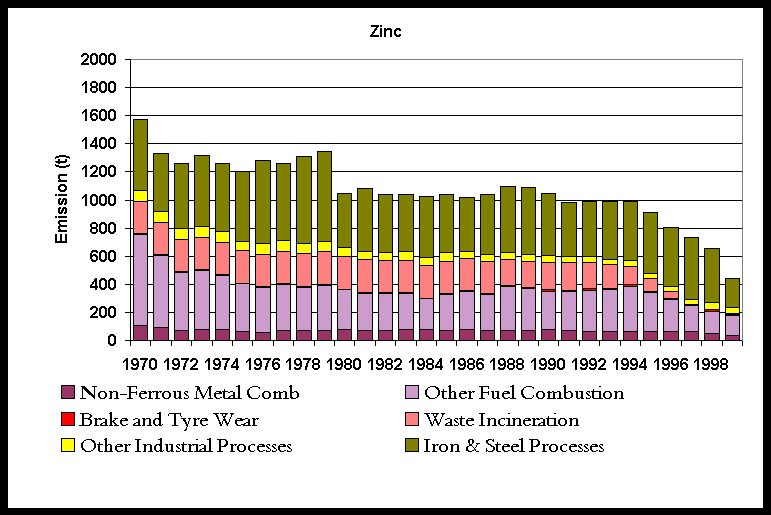
Spatial Disaggregation of Heavy Metals
All of the heavy metal emission estimates presented
here have been spatially disaggregated, and UK maps are presented in Figures
6.13 to 6.22. The key features that are evident from the maps are briefly
considered here:
Arsenic
Significant emissions arise from coal combustion, and consequently
emissions in Northern Ireland are noted to be relatively high. Individual
points sources are also evident.
Cadmium
The major source for 1999 arises from activities associated with
non-ferrous metals. This proves difficult to identify from the UK map.
Chromium and Copper
The dominant sources of Chromium are coal combustion and iron and steel
production processes, and for Copper- coal combustion, iron and steel
manufacture and non-ferrous metals production. From the UK emission maps it can
be seen that there are a number of point sources, and elevated emissions in
Northern Ireland for both of these pollutants.
Lead
In 1999 the majority of lead emissions arise from road transport
activities, although a significant contribution comes from the non-ferrous
metal industry. The major road network is clearly visible from the UK emission
map indicating road transport as the dominant source sector.
Mercury
The major sources of mercury in 1999 were waste incineration, coal
combustion and specific industrial activities. As a result the UK emission map
highlights a number of point sources with a more widespread coverage.
Nickel
Emissions of Nickel are dominated by the combustion of coal and heavy
fuel oil. Consequently areas of the country with refinery activities are
highlighted. It is also interesting to note that urban areas are not elevated,
with high population density areas often resulting in lower emissions per 1x1
km grid cell. This is due to the higher use of gas in the domestic sector in
areas of higher population density.
Selenium
Emissions of selenium are dominated by the glass industry and coal
combustion. Consequently the UK emissions map displays some major point
sources, and other areas with very low emissions.
Vanadium
Vanadium emission primarily arise from the combustion of heavy fuel
oils- in the refinery and industrial sectors. As a result a large number of
point sources may be identified from the emissions map, and large
conurbations/areas of high population density show low emissions.
Zinc
Zinc emissions primarily arise from combustion in the non-ferrous metals
sector, iron and steel production processes and road transport (brake and tyre
wear). As a result the UK emissions map highlights the road network and a
number of point sources. However, the point sources are difficult to see due to
the large number of grid cells that are impacted upon by emissions from the
road transport sector.
|
Fig 6.20 Spatially Disaggregated UK
Emissions- Arsenic |
Fig 6.21 Spatially Disaggregated UK
Emissions-Cadmium |
|
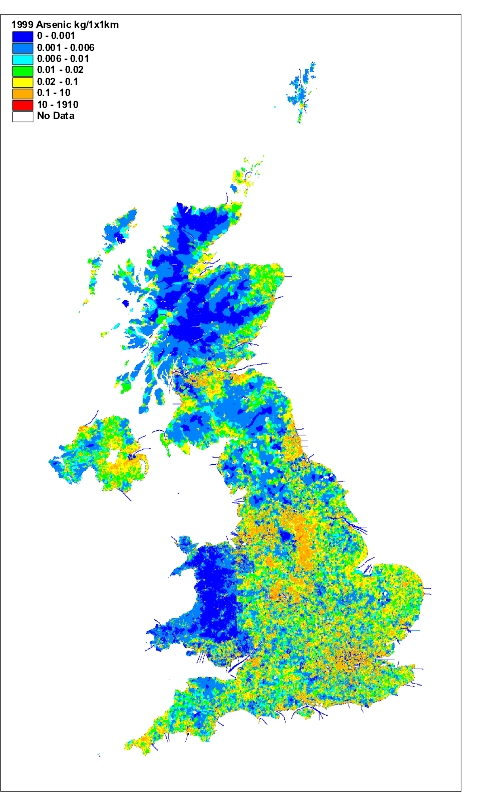
|
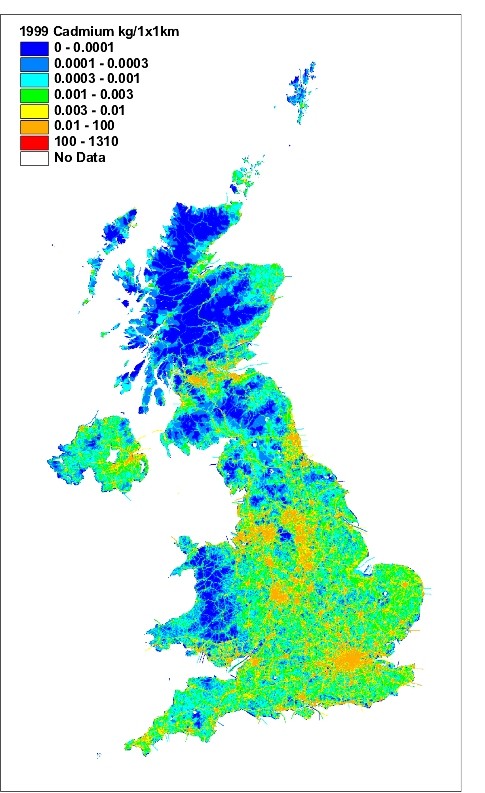
|
|
|
|
|
Fig 6.22 Spatially Disaggregated UK
Emissions Chromium |
Fig 6.23 Spatially Disaggregated UK
Emissions- Copper |
|
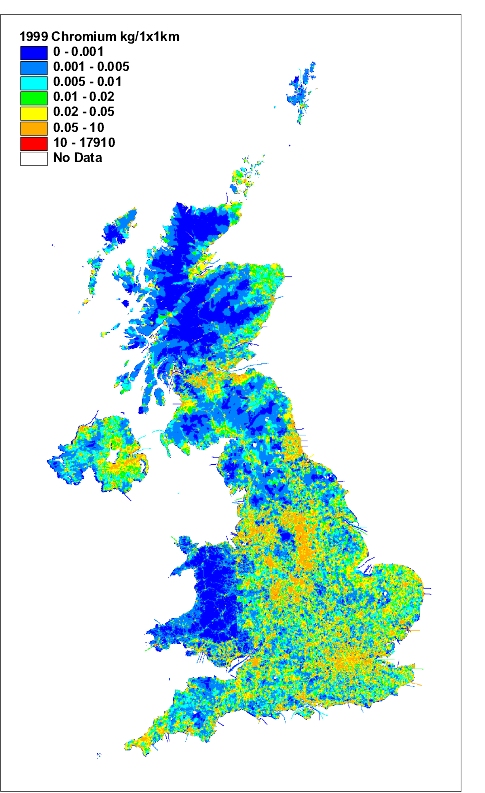
|
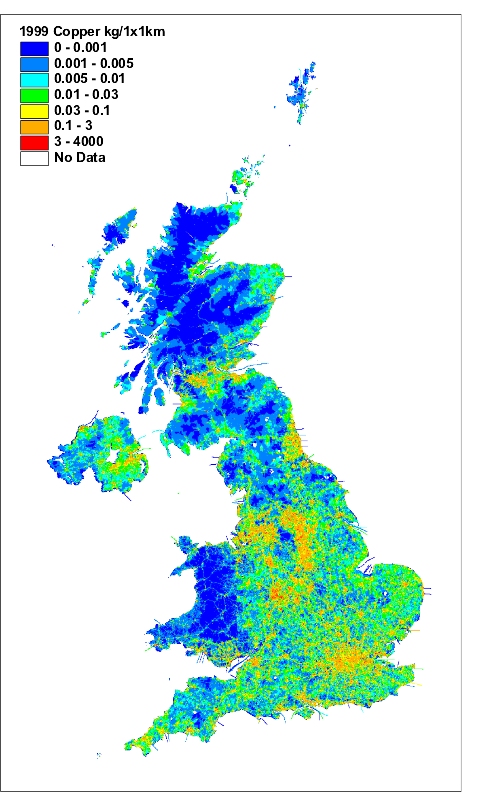
|
|
Fig 6.24 Spatially Disaggregated UK
Emissions of Lead |
Fig 6.25 Spatially Disaggregated UK
Emissions of Mercury |
|
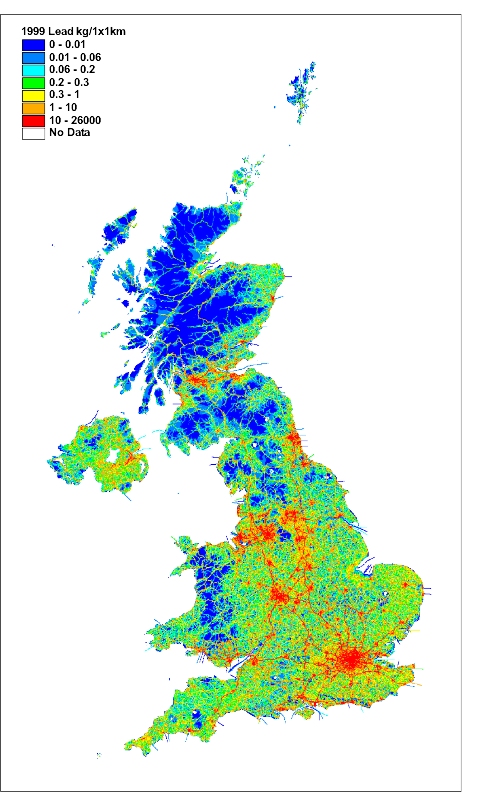
|
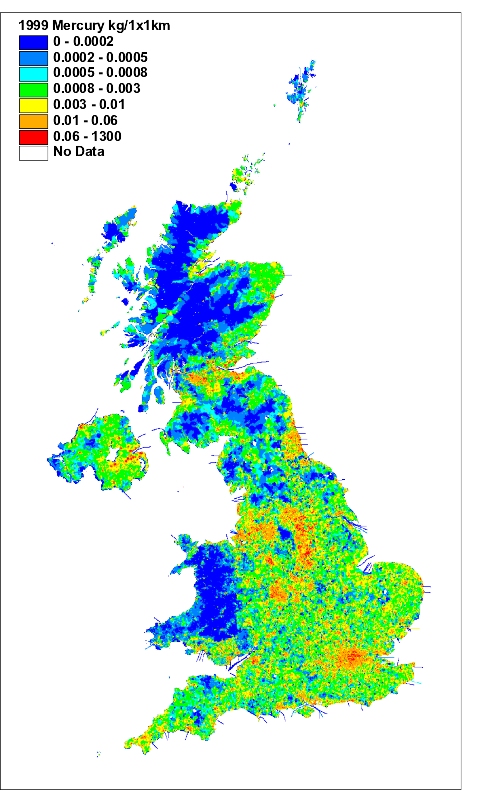
|
| |
|
|
Fig 6.26 Spatially Disaggregated UK
Emissions of Nickel |
Fig 6.27 Spatially Disaggregated UK
Emissions- Selenium |
|
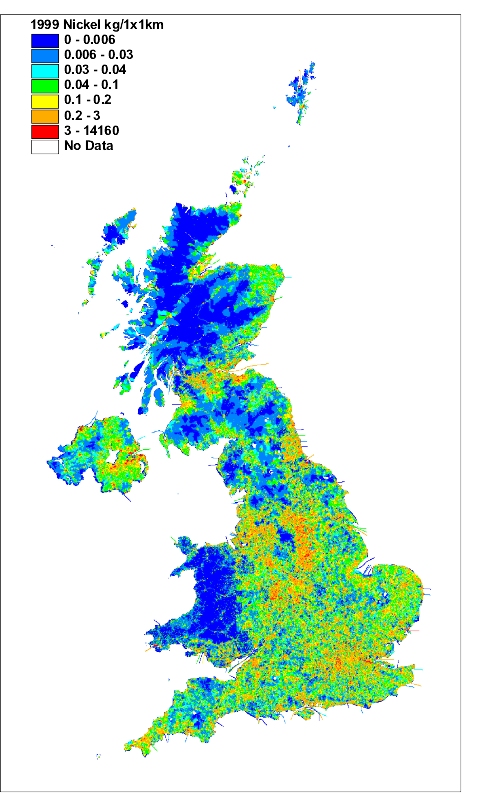
|
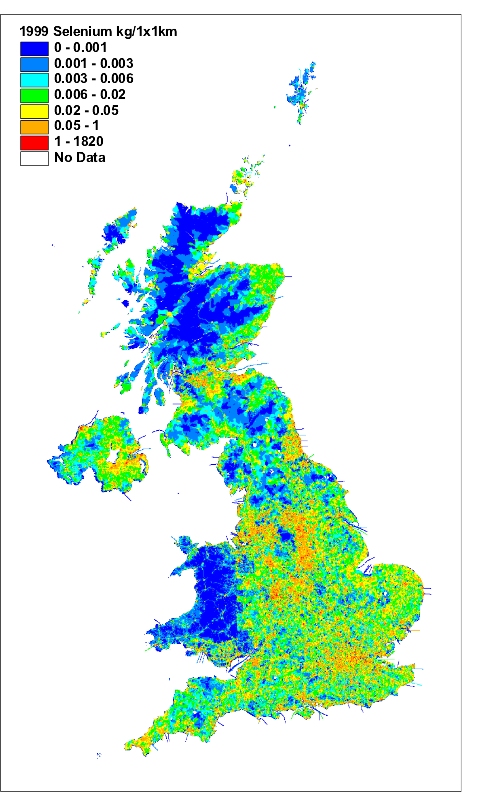
|
|
Fig 6.28 Spatially Disaggregated UK
Emissions- Vanadium |
Figure 6.29 Spatially Disaggregated UK
Emissions of Zinc |
|
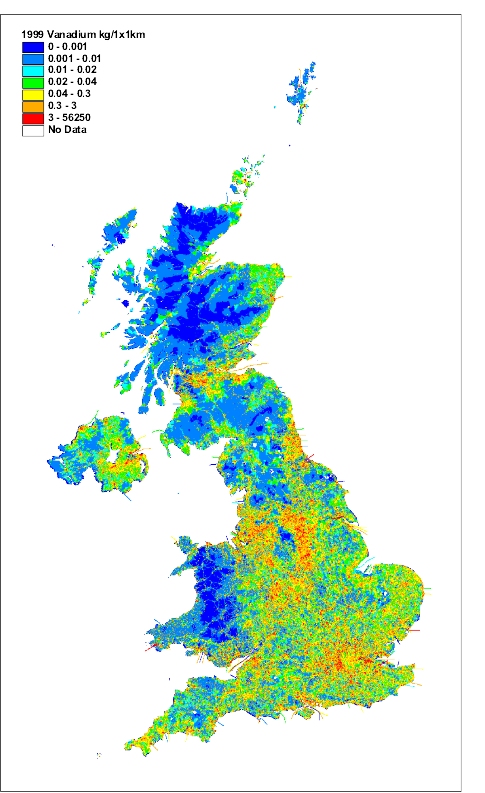
|
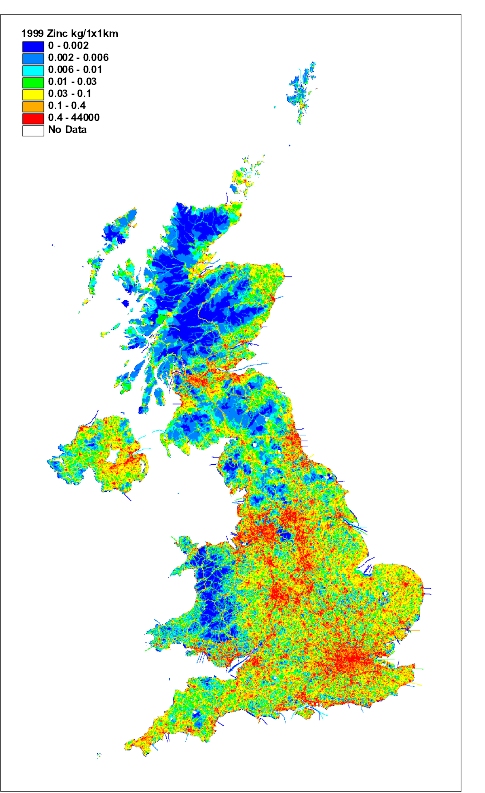
|




















